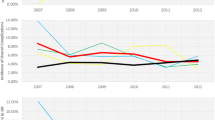Abstract
Background
The surgical residency system ensures supervised practices to progressively move from simple to complex surgical procedures. However, ethical dilemmas could arise if patient outcome is negatively affected by this learning methodology. The objective of this study was to evaluate whether the supervised participation of residents acting as operating surgeons influences the postoperative complication rate.
Methods
Surgeries performed between June 2010 and May 2011 were analyzed. The Dindo-Clavien classification was used to stratify the severity of complications. The complication rates of patients operated by supervised residents (SR) and trained surgeons (TS) were compared considering potential confounders related to the patient and surgical procedure.
Results
A total of 3697 consecutive surgical procedures were included. Age, gender, and American Society of Anesthesiologists (ASA) risk were not different between patients of both groups. The overall complication rate was 10.8 %, without significant differences between the SR and TS groups (9.8 vs. 11.4 %; P = 0.14). The severity of complications was similar in both groups. Multivariate analysis adjusted for confounders confirmed that resident participation was not an independent risk factor for complications (odds ratio 1.52; 95 % CI 0.79–2.92; P = 0.20).
Conclusions
Supervised resident participation, as operating surgeon, does not negatively impact postoperative patient outcome. Residency training may therefore be considered as an ethical and safe learning methodology whenever implemented in the framework of an academic teaching hospital.

Similar content being viewed by others
References
Gibbon JH (1995) The education of a surgeon. Ann Surg 142:321–328
Pellegrini C (2006) Surgical education in the United States. Navigating the white waters. Ann Surg 244:335–342
Davis SS Jr, Husain FA, Lin E, Nandipati KC, Perez S, Sweeney JF (2013) Resident participation in index laparoscopic general surgical cases: impact of the learning environment on surgical outcomes. J Am Coll Surg 216(1):96–104
Harrington DT, Roye GD, Ryder BA, Miner TJ, Richardson P, Cioffi WG (2007) A time-cost analysis of teaching a laparoscopic entero-enterostomy. J Surg Educ 64:342–345
Bridges M, Diamond DL (1999) The financial impact of teaching surgical residents in the operating room. Am J Surg 177:28–32
Itani KM, DePalma RG, Schifftner T, Sanders KM, Chang BK, Henderson WG, Khuri SF (2005) Surgical resident supervision in the operating room and outcomes of care in Veterans affairs hospitals. Am J Surg 190:725–773
Fischer CP, Hong JC (2006) Early perioperative outcomes and pancreaticoduodenectomy in a general surgery residency training program. J Gastrointest Surg 10:478–482
Khuri SF, Henderson WG, Daley J, Jonasson O, Jones RS, Campbell DA Jr et al (2008) Successful implementation of the Department of Veterans Affairs’ National Surgical Quality Improvement Program in the private sector: the patient safety in surgery study. Ann Surg 248:329–336
Khuri SF, Najjar SF, Daley J, Krasnicka B, Hossain M, Henderson WG et al (2001) Comparison of surgical outcomes between teaching and nonteaching hospitals in the Department of Veterans Affairs. Ann Surg 234:370–382
Coates KW, Kuehl TJ, Bachofen CG, Shull BL (2001) Analysis of surgical complications and patient outcomes in a residency training program. Am J Obstet Gynecol 184:1380–1383
Kauvar DS, Braswell A, Brown BD, Harnisch M (2006) Influence of resident and attending surgeon seniority on operative performance in laparoscopic cholecystectomy. J Surg Res 132:159–163
Bulletin of the Committee on Labor Matters of the Argentine Surgical Association 2005. http://www.aac.org.ar/imagenes/nomenclador/nomenclador.pdf.
Dindo D, Demartines N, Clavien PA (2004) Classification of surgical complications: a new proposal with evaluation in a cohort of 6336 patients and results of a survey. Ann Surg 240:205–213
Gaba DM (2007) The future vision of simulation in healthcare. Simulation Healthc. J Soc Simulation Healthc 2:126–135
Santen SA, Hemphill RR, McDonald MF, Jo CO (2004) Patients’ willingness to allow residents to learn to practice medical procedures. Acad Med 79(2):144–147
Knifed E, Goyal A, Bernstein M (2010) Moral angst for surgical residents: a qualitative study. Am J Surg 199(4):571–576
Kocher MS (2002) Ghost surgery: the ethical and legal implications of who does the operation. J Bone Joint Surg Am 84-A(1):148–150
Offner PJ, Hawkes A, Madayag R, Seale F, Maines C (2003) General surgery residents improve efficiency but not outcome of trauma care. J Trauma 55:14–19
Kiran RP, Ahmed Ali U, Coffey JC, Vogel JD, Pokala N, Fazio VW (2012) Impact of resident participation in surgical operations on postoperative outcomes: National Surgical Quality Improvement Program. Ann Surg 256(3):469–475
Scarborough JE, Bennett KM, Pappas TN (2012) Defining the impact of resident participation on outcomes after appendectomy. Ann Surg 255(3):577–582
Borja-Cacho D, Parsons HM, Habermann EB, Rothenberger DA, Henderson WG, Al-Refaie WB (2010) Assessment of ACS NSQIP’s predictive ability for adverse events after major cancer surgery. Ann Surg Oncol 17(9):2274–2282
Conflicts of interest
None of the authors of this manuscript has any direct or indirect commercial financial incentive associated with the publication of this paper. The funding involved in this work has been provided by our institution.
Author information
Authors and Affiliations
Corresponding author
Rights and permissions
About this article
Cite this article
de Santibañes, M., Alvarez, F.A., Sieling, E. et al. Postoperative complications at a university hospital: is there a difference between patients operated by supervised residents vs. trained surgeons?. Langenbecks Arch Surg 400, 77–82 (2015). https://doi.org/10.1007/s00423-014-1261-z
Received:
Accepted:
Published:
Issue Date:
DOI: https://doi.org/10.1007/s00423-014-1261-z




